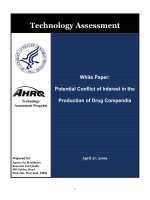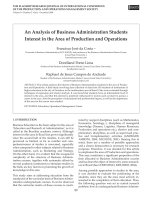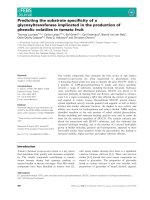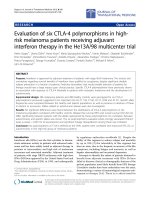POTENTIAL CONFLICT OF INTEREST IN THE PRODUCTION OF DRUG COMPENDIA doc
Bạn đang xem bản rút gọn của tài liệu. Xem và tải ngay bản đầy đủ của tài liệu tại đây (600.81 KB, 111 trang )
Technology Assessment
Technology
Assessment Program
Prepared for:
Agency for Healthcare
Research and Quality
540 Gaither Road
Rockville, Maryland 20850
White Paper:
Potential Conflict of Interest in the
Production of Drug Compendia
April 27, 2009
1
White Paper:
Potential Conflict of Interest in the
Production of Drug Compendia
PROJECT ID: CMPE1207
April 27, 2009
Duke Evidence-based Practice Center
Duke Center for Clinical Health Policy Research
2200 West Main Street, Suite 220
Durham, NC 27705
(919) 286-3399
Ross McKinney, MD
Amy P. Abernethy, MD
David B. Matchar, MD
Jane L. Wheeler, MSPH
This report is based on research conducted by the Duke Evidence-Based
Practice Center under contract to the Agency for Healthcare Research and
Quality (AHRQ), Rockville, MD (Contract No HHSA 290 2007 10066-1). The
findings and conclusions in this document are those of the author(s) who are
responsible for its contents; the findings and conclusions do not necessarily
represent the views of AHRQ. No statement in this article should be construed
as an official position of the Agency for Healthcare Research and Quality or of
the U.S. Department of Health and Human Services.
The information in this report is intended to help health care decision-makers;
patients and clinicians, health system leaders, and policymakers, make well-
informed decisions and thereby improve the quality of health care services. This
report is not intended to be a substitute for the application of clinical judgment.
Decisions concerning the provision of clinical care should consider this report in
the same way as any medical reference and in conjunction with all other
pertinent information, i.e., in the context of available resources and
circumstances presented by individual patients.
This report may be used, in whole or in part, as the basis for development of
clinical practice guidelines and other quality enhancement tools, or as a basis for
reimbursement and coverage policies. AHRQ or U.S. Department of Health and
Human Services endorsement of such derivative products may not be stated or
implied.
All of the investigators are affiliated with Duke University which is an NCCN
Institution. Dr. Abernethy currently serves on the fatigue guideline panel (though
this group has no relationship to chemotherapy drugs). There are no other
conflicts to disclose.
Copyright Information
White Paper: Potential Conflict of Interest in the Production of Drug Compendia
is copyrighted by the Agency for Healthcare Research and Quality (AHRQ). The
product and its contents may be used and incorporated into other materials* on
the condition that the contents are not changed in any way (including covers and
front matter) and that no fee is charged by the reproducer of the product or its
contents for its use. The product may not be sold for profit or incorporated into
any profit-making venture without the expressed written permission of AHRQ.
Specifically:
• When the document is reprinted, it must be reprinted in its entirety without
any changes.
• Entities shall not publish excerpts without AHRQ review and approval.
• For AHRQ-approved excerpts, use the following citation.
iii
*Note: This paper contains material copyrighted by others. For material noted as
copyrighted by others, the user must obtain permission from the copyright
holders identified herein.
Citation
McKinney et al. White Paper: Potential Conflict of Interest in the
Production of Drug Compendia. (Prepared by the Duke Evidence Based
Practice Center under Contract HHSA 290 2007 10066 I.) Rockville, MD.
Agency for Healthcare Research and Quality. April 2009. Available at
Acknowledgments
The authors wish to acknowledge the contributions of Rebecca Gray, EPC Editor, R.
Julian Irvine, Project Coordinator, and Diane Garrison, EPC Program Manager.
iv
Contents
1.0 Introduction 1
2.0 Background 3
2.1 Use of Drug Compendia in Coverage Determinations 3
2.2 Definition of Conflict of Interest, and its Relation to Drug Compendia 6
2.3 Entities Involved in Compendia Development and their Potential Conflicts
of Interest 7
2.4 Examples of Conflict of Interest in the Development of Clinical Practice
Guidelines 9
2.4.1 rhAPC and the Surviving Sepsis Campaign 9
2.4.2 Guideline development for erythropoiesis-supporting proteins 11
2.5 Rationale for this Study 14
2.6 Purpose of this Study 15
3.0 Methods 17
4.0 Results 19
4.1 Components of an Ethical Framework to Approach Conflict of Interest in
Compendia 19
4.1.1 Conflict of interest in evidence sources 20
4.1.2 Conflict of interest in data availability 23
4.1.3 Conflict of interest in selection of indications and evidence 24
4.1.4 Conflict of interest in interpretation of evidence 26
4.2 Compendia Development, Review Processes, and Conflict-of-Interest
Policies 27
4.2.1 The process of compendia development 27
4.2.2 The review processes of compendia 29
4.3 Example of the Potential for Conflict of Interest in Compendia:
v
DRUGDEX and Allegations of Conflict of Interest 34
4.4 Print and Electronic Information on Compendia Conflict-of-Interest
Policies 36
4.5 Teleconferences with Compendia Personnel 37
4.6 Evaluating the Impact of Conflict of Interest on Compendia 38
5.0 Discussion 40
5.1 Compendia Play an Important Role in Health Care, Despite the Inevitable
Challenge of Conflict of Interest 40
5.2 Compendia Differ in their Conflict-of-Interest Policies, and Likewise
Exhibit Diverse Areas for Improvement 41
5.3 Conflict of Interest is Not Always a Straightforward Issue 43
5.4 Each Compendium Faces its own Areas of Risk Where Potential
Conflicts of Interest Might Arise 45
5.5 Problems when the Compendia’s Approach to Conflict of Interest Relies
on Disclosure 50
5.6 Other Mechanisms Could Help Curb the Influence of Conflict of Interest
on Compendia 51
6.0 Authors’ Commentary 55
References 59
Acronyms and Abbreviations 66
Figures
Figure 1: Editorial Flow and Potential Conflict of Interest Problems in the
Preparation of Compendia Articles 68
vi
vii
Tables
Table 1: Positive Objectives for Producers and Users of Drug Compendia 69
Table 2: Summary of Compendia Conflict-of-Interest Policies 71
Table 3: NCCN Guideline Groups and Declared Financial Conflict of Interest
(FCOI) 75
Table 4: Discussion of agent-cancer combinations by compendia 76
Appendices
Appendix A: Included Articles from the Literature Search 77
Appendix B: Results of Teleconferences with Key Compendia Editorial Personnel 82
Appendix C: Script for Teleconferences with Key Compendia Editorial Personnel 98
Appendix D: Response from DRUGDEX following posting of draft report on
Agency website 102
1.0 Introduction
This white paper, which was commissioned by the Agency for Healthcare
Research and Quality (AHRQ), with sponsorship from the Centers for Medicare &
Medicaid Services (CMS), explores the concern that conflict of interest may
potentially influence the inclusion/exclusion decisions, editorial processes,
production, and content of current drug compendia. Drug compendia –
pharmacopeia providing information on drugs, their effectiveness, safety, toxicity,
and dosing – are frequently used to determine whether a medication has a role in
the treatment of a particular disease; these roles include both therapeutic uses
approved by the U.S. Food and Drug Administration (FDA) and off-label
indications. Policy enactments have also resulted in use of the compendia to
inform reimbursement decisions made by CMS and other third-party payers.
The pages that follow provide: (1) a description of compendia processes,
delineating points at which conflict of interest may arise; (2) an ethical framework
for evaluating the potential presence and influence of conflict of interest in
compendia; (3) results of an investigation into the policies and practices of four
specific compendia (those officially approved for use in making Medicare
coverage determinations) with regard to conflict of interest; and (4) a discussion
of the adequacy of compendia approaches to conflict of interest, problems with
conflict of interest that have been reported, and opportunities for minimizing
conflict of interest in the compendia to ensure an objective and impartial system.
Results presented in this white paper do not constitute a critique of existing
compendia. Rather, the investigators explored specific questions with the
1
2
intention of: identifying, if warranted, potential areas for improvement; assisting
AHRQ and CMS in developing a systematic approach to the understanding of
conflict-of-interest-related bias in drug compendia; and contributing to the effort
to hone the compendia system such that it provides a digest of accurate, timely,
unbiased, and complete evidence to clinicians as a reference for clinical
decision-making.
2.0 Background
2.1 Use of Drug Compendia in Coverage Determinations
A compendium is a listing of drugs and biological agents which summarizes
evidence on the effectiveness of each drug or biologic, and provides information
regarding clinical indications and proper dosing. Compendia may recommend
uses of a drug or biologic other than those approved by the FDA if scientific
evidence supports those uses; in such cases, the use is termed an “off-label”
indication.
For the past 15 years, off-label prescribing in oncology has been facilitated by
Medicare insurability of off-label uses of anticancer drugs and biologics, as
stipulated under Social Security Act Section 1861(t)(2)(B)(ii)(I) and (II), under the
Omnibus Budget Reconciliation Act of 1993. This statute recognized certain
compendia as authoritative sources for determining a “medically-accepted
indication” of drugs and biological agents used off-label in an anticancer
chemotherapeutic regimen, unless the Secretary of Health and Human Services
determines otherwise. The statute originally indicated that medically-accepted
indications would be determined by three designated compendia: American
Medical Association Drug Evaluations (AMA-DE), American Hospital Formulary
Service Drug Information (AHFS-DI), and United States Pharmacopeia Drug
Information (USP-DI). Of the three originally approved compendia, only one,
AHFS-DI,
1
still exists as of the writing of this report.
Due to the reduction in the number of originally approved compendia, and
propelled by requests for the addition of new compendia to the approved list,
3
CMS commissioned AHRQ to conduct a Technology Assessment reviewing the
structure and processes of several published compendia. The resulting
Technology Assessment, prepared by the Duke and Tufts Evidence-based
Practice Centers (EPCs) and entitled “Compendia for coverage of off-label uses
of drugs and biologics in an anticancer chemotherapeutic regimen,” compared
five compendia for their practices regarding off-label anti-cancer drugs.
2, 3
It
found that the compendia often did not cite the most current or best performed
clinical trials as part of their evidence base. There were large variations in
whether, and how quickly, off-label indications were added to the compendia
included in the study. DRUGDEX
4
, for example, tended to include more
indications as substantiated by evidence than the other compendia, but did not
consistently utilize the best designed or most timely available studies as the
evidence underlying its decisions. The limited number of cited studies made it
difficult to evaluate the basis of the recommendations made by all five compendia
studied. DRUGDEX listed the most off-label indications, and AHFS-DI
1
the
fewest. Given the lack of evidentiary citations, it was impossible to ascertain
which set of indications (i.e., which compendium) most accurately reflected
current best evidence.
In 2006, CMS convened the Medicare Evidence Development & Coverage
Advisory Committee (MEDCAC) to hear a formal presentation of findings from
the Duke/Tufts EPCs’ Technology Assessment, and to make recommendations
regarding desirable characteristics of compendia that would be used to identify
appropriate indications for drugs and biologics in cancer treatment. The
4
MEDCAC recommendations
5
included several items relevant to public
transparency and minimization of conflict of interest: (a) “detailed description of
the evidence reviewed for every individual listing”; (b) “use of prespecified
published criteria for weighing evidence”; (c) “use of prespecified published
process for making recommendations”; (d) “publicly transparent process for
evaluating therapies”; and (e) “process for public identification and notification of
potential conflicts of interest of the compendia's parent and sibling organizations,
reviewers, and committee members, with an established procedure to manage
recognized conflicts.”
In 2008, CMS approved three compendia in addition to AHFS-DI, which had
been approved by statute in 1993.
1
The new compendia were: the National
Comprehensive Cancer Network (NCCN) Drugs & Biologics Compendium
6
,
DRUGDEX
4
, and Clinical Pharmacology
7
– raising to four the total number of
compendia viewed as authoritative sources of information on “medically-
accepted indications.”
While the original statute that stipulated which compendia were approved
pertained specifically to CMS, most other third-party payers and state legislatures
have followed suit.
8
The four approved compendia thus heavily influence, if not
determine, treatment decisions for many cancer patients. The quality of their
evidence and the impartiality of their methods are thus of paramount importance.
In order to address these concerns, Congress has recently enacted legislation to
further reduce conflicts of interest in compendia.
5
2.2 Definition of Conflict of Interest, and its Relation to Drug
Compendia
A conflict of interest exists when an individual or corporate entity possesses
more than one motivation for trying to achieve an objective. A formal definition is
presented by Thompson in the New England Journal of Medicine in 1993: “A
conflict of interest is a set of conditions in which professional judgment
concerning a primary interest (such as a patient's welfare or the validity of
research) tends to be unduly influenced by a secondary interest (such as
financial gain).
9
As described above, certain drug compendia have become regarded as
authoritative sources of information to support coverage determinations of off-
label uses of anti-cancer drugs and biologics. By definition, drug compendia
include information that has major financial implications for drug manufacturers.
Listing of a product in an approved compendium confers a financial advantage to
industry. The basic motivation to attain listing in the compendia introduces
potential for conflict of interest in ongoing compendia development processes.
This potential conflict of interest exists at multiple levels, as experienced by
various entities involved with the compendia and their development.
2.3 Entities Involved in Compendia Development and their
Potential Conflicts of Interest
Multiple parties are affected by decisions made during the development of
drug compendia. These parties include the public, health care providers,
6
pharmaceutical companies, private insurers, compendia staff, editorial boards of
compendia, and compendia publishers. For each of these parties, the
compendia and their entries have distinct reasons for importance (Table 1); thus
each party may have specific – possibly conflicting – interests with respect to
compendia development.
Pharmaceutical manufacturers have a direct interest in maximizing the
number of accepted indications that are listed in approved compendia, and thus
eligible for payment. Given this basic motivation, industry could be expected to
favor policies that accept marginal data on a drug’s effectiveness as evidence
justifying reimbursement for that agent.
Compendia writers who are also practicing physicians have many reasons to
favor a more liberal listing approach. For example, nephrologists who own or
depend on dialysis centers have financial reasons to favor higher hemoglobin
standards in chronic renal failure since those centers may be reimbursed at an
above-cost rate for the relevant medications to increase erythropoiesis.
10
In most
cases, it also behooves practicing physicians to have more, rather than fewer,
treatment options available to offer to their patients. This is particularly the case
with rare diseases where specific FDA-registration for the indication may not
occur but the available evidence supporting the drug-orphan disease indication
may be mentioned in the compendia, in which case the lack of FDA-registration
does not correspond with the lack of need for therapy. Practicing physicians may
be concerned that the seemingly slow process for FDA registration of a product
for a specific indication limits access of potentially therapeutic treatments; this is
7
particularly urgent in settings of life-limiting illness. In addition, some physicians
offer treatments as a mechanism to maintain hope in late-stage diseases such as
cancer, even without an evidence base to support these uses of the treatment
agents.
Insurance companies have a direct financial interest in limiting the number of
accepted indications listed in approved compendia, while generally agreeing to
pay in situations where the evidence is meaningful and secure. For the insurers,
the financial incentives are clear, since every additional indication implies
additional costs that must be covered – particularly an issue given the expense of
some newer and less scientifically established therapeutic agents. The financial
pressure to limit the size of the accepted indication list is particularly a factor for
profit- or margin-seeking entities (which may be structured as non-profits under
tax laws). At the same time, insurers have a public interest reason to avoid a
carte blanche approach for therapeutics, since this approach drives up the
aggregate cost of health care and, unless evidence-based, may or may not
improve health outcomes. But despite these pressures, there are market
reasons for an insurance company to cover a wider number of therapies so that
their customers are more pleased with the company’s service. In addition, using
the best available therapy may be cost effective in the long term, since it may
have the potential to avoid future treatment expenses.
2.4 Examples of Conflict of Interest in the Development of
Clinical Practice Guidelines
8
Most of the general academic literature relevant to conflict of interest in
compendia focuses on guideline-writing groups, which are very analogous. The
NCCN compendium is, for example, explicitly based on the work of NCCN
guideline writing committees. The degree of the concern about conflicts of
interest was made clear in 2002, when Choudhry and co-authors found that 87%
of guideline authors had some relationship with a pharmaceutical manufacturer;
the mean number of companies with whom guideline authors had financial
conflicts of interest was 10.5.
11
Fifty-nine percent of authors had relationships
with companies whose products were considered in the guideline. Two
prototypical situations that have been very actively debated are the “Surviving
Sepsis Campaign” and the development of guidelines regarding erythropoiesis
stimulating products.
2.4.1 rhAPC and the Surviving Sepsis Campaign
. The basic issue in the
Surviving Sepsis case was the approach that Eli Lilly took to marketing its drug,
recombinant human activated protein C (rhAPC; brand name Xigris®). Eichacker
and colleagues published an editorial in the New England Journal of Medicine
12
which closely echoed an editorial published by Christian Wiedermann in Wiener
Klinische Wochenschrift in 2005.
13
Both noted that Lilly contracted with a public
relations firm to market the concept that failure to use Xigris® was unethical,
despite its cost. This public relations firm created the “Values, Ethics and
Rationing in Critical Care Task Force” (VERICC). VERICC recruited well-known
bioethicists as members in order to provide credibility. The second element to
9
their marketing effort was to support an existing guideline-writing group, the
International Sepsis Forum (ISF), which looked favorably on rhAPC as a therapy.
Lilly was one of the seven corporate sponsors for the ISF. The ISF, European
Society of Intensive Care Medicine, and American Society of Critical Care
Medicine (SCCM) joined together to lead the “Surviving Sepsis Campaign,” for
which Lilly was the largest sponsor. The campaign endorsed the use of rhAPC,
based on a study known as the
Recombinant Human Activated Protein C
Worldwide Evaluation in Severe Sepsis Trial (PROWESS).
14
In contrast to the
Surviving Sepsis Guideline position, the FDA and the European Medicines
Agency (EMEA) limited the license of the drug based on concerns regarding the
PROWESS data. In particular, subgroups of trial participants receiving rhAPC
had higher mortality than those receiving placebo. The Surviving Sepsis group
was criticized for their relatively uncritical endorsement.
The Surviving Sepsis controversy illustrates several aspects of conflict of
interest relevant to compendia. As an evidence source, the Surviving Sepsis
Guidelines were accused of ignoring subsequent studies that were less favorable
to rhAPC, such as the Administration of Drotrecogin Alfa (Activated) in Early
Stage Severe Sepsis (ADDRESS) and Researching Severe Sepsis and Organ
Dysfunction in Children: a Global Perspective (RESOLVE) trials, both of which
were terminated early because they were deemed unlikely to show benefit in
their primary endpoints, while demonstrating significant toxicities associated with
rhAPC.
15, 16
The studies considered in the product endorsement were all
sponsored by Eli Lilly; their outcomes suggest that they were performed fairly, if
10
interpreted generously. Additionally, the interpretation of the data raised
questions about conflict of interest, since some critics stated that the resulting
guidelines were much more positive about rhAPC than the data justified.
17
In an editorial supporting the Surviving Sepsis Campaign, Charles Durbin
(President of the SCCM) took a differing set of positions.
18
First, he defended
Lilly’s support for disseminating the guidelines, arguing that without such support
most guideline documents are not widely read or used. He made the point that
there is little public funding for publicizing guidelines, and that the guideline
writers applied for industry sponsorship. He noted that the fact that Lilly funded a
large portion of the budget was never hidden, nor was there any attempt to
camouflage Lilly’s reason for interest. Dr. Durbin stated that the societies’ rules
meant Lilly could not have influenced the actual guidelines, claiming that “such
influence has not been and cannot be substantiated.”
2.4.2 Guideline development for erythropoiesis-supporting proteins
. A
second recent illustration of controversy regarding the influence of commercial
interests on guidelines surrounded the use of erythropoietin and erythropoiesis-
supporting proteins (ESPs) for anemia in chronic renal disease. In this case,
financial conflicts of interest were transparently disclosed. The guideline
committee made a controversial, even surprising, recommendation aligned with
the interests of the pharmaceutical manufacturers. Public and professional
skepticism about the value of the guidelines was profound.
11
The guidelines in question, published in 2006, were written under the aegis of
the National Kidney Foundation.
19
The concerns were clearly defined by
nephrologist Daniel Coyne in 2007.
10, 20
He noted that the guideline committee
recommended the use of ESPs to maintain hemoglobin between 11 and 13
gm/dL, although the previous target range had been 11-12 gm/dL. The higher
target range stood to benefit several groups: the makers of ESPs, nephrologists,
dialysis facilities, and, potentially, patients. Coyne posited that the National
Kidney Foundation also stood to benefit from an ESP-favorable report, since it
received much of its support from corporations linked to ESPs. Amgen itself was
the principal financial sponsor of the guideline, despite oversight of the National
Kidney Foundation. Coyne noted that 14 of the 16 members of the guideline
committee had personal financial relationships with companies that stood to
benefit from higher hemoglobin targets.
The element in the guideline-writing process that raised the most concern
was that of conflict of interest in evidence selection; specifically, the review
process neglected to include data from two major studies, the Cardiovascular
Risk Reduction by Early Anemia Treatment with Epoetin Trial (CREATE)
21
and
the Correction of Hemoglobin and Outcomes in Renal Insufficiency Trial
(CHOIR).
22
Both studies demonstrated increased risk of cardiovascular events in
patients assigned to higher hemoglobin targets (13 to 15 in CREATE, 13.5 in
CHOIR). The guideline-writing committee was given early access to the
outcomes of these studies, although the formal presentation of the two studies
did not occur until the same meeting in April 2006 where the guidelines were
12
announced. The committee rules specified that reviews would be limited to
published results and that, where the information in publications was insufficient:
In the absence of strong or moderately strong quality
evidence or when additional considerations did not support
strong or moderately strong evidence-based guideline
recommendations, the Work Group could elect to issue
CPRs [clinical practice recommendations] based on
consensus of expert opinions. These recommendations are
prefaced by “In the opinion of the Work Group,” and are
based on the consensus of the Work Group that following
the recommendations might improve health outcomes.
19
The upper bound for hemoglobin was judged to be insufficiently elucidated by
randomized controlled trials, so a clinical practice recommendation was made on
the basis of expert opinion. The fact that the opinions might soon be swayed by
well-conducted randomized trials of which the committee was aware did not
change the recommendations.
Controversy has surrounded the question of whether process policies or
conflict of interest drove the final recommendations regarding ESPs.
20, 23, 24
Regardless, the presence of potential conflicts of interest clearly created
skepticism about the validity of the recommendations. In addition, the situation
pointed out the difficulty for the end user of evaluating guidelines created in a
process which included conflicted individuals; it is nearly impossible for the
guideline user to ascertain the role that conflict of interest may have played in the
13
committee process and the final recommendations. A guideline that is based on
a mixture of opinion and clinical trial data poses a challenge to interpret;
compendia are faced with the difficulty of evaluating “generous” interpretations
that favor industry and their influence on clinical practice guidelines.
2.5 Rationale for this Study
A core function of drug compendia is to use evidence from systematic,
scientific studies to make a determination on whether or not to include an
indication in their drug summaries. Compendia face the objective task of
evaluating the evidence for the novel use of a drug or device, amid the
competing pressures of: (1) a desire to limit prescriptions for the drug to
situations where evidence is sufficient to justify its use; (2) a desire to make
products available to everyone who could clinically benefit; and (3) the fact that
CMS approval of payment can have major financial ramifications. The evidence
used by the compendia writers may be as complete as a large randomized
controlled trial published in a respected peer-reviewed journal, or as limited as a
meeting abstract describing a small case series that has yet to be fully peer
reviewed.
3
Each publisher has distinct criteria and standards for inclusion of
evidence in their compendium.
There are several concerns regarding the use of compendia as
reimbursement guidelines, some of which have been recently summarized.
2
This
role was developed to meet the need for a standard to assist with coverage
determinations regarding the many off-label uses of FDA-approved drugs. In
14
oncology, this need is particularly important given the high cost of many new
treatments and the authority of physicians to write prescriptions for any approved
medication, regardless of whether the particular indication is part of the FDA-
approved package insert.
Compendia approved by CMS purport to evaluate clinical trial evidence from
many sources, use experts to assess the validity of that evidence, and publish
summaries in a clear and concise format. Concerns have been raised that
financial conflicts of interest may affect decisions made by compendia
producers.
25
This paper explores the standards and policies that compendia use
to minimize the impact of conflict of interest, and the application of those policies.
It describes the processes through which compendia add new drug/biologic
indications, the points in these processes at which conflicts of interest could
enter, the current conflict-of-interest policies of the four compendia used by CMS,
and the evidence that the compendia uphold these policies.
2.6 Purpose of this Study
This study was designed to explore the following research questions:
1. What potential conflicts of interest exist in the production of drug
compendia?
2. What practices and policies have drug compendia instituted to protect
against bias introduced by conflict of interest?
15
16
3. Does available evidence from medical literature, as well as mainstream
media, suggest that these policies and practices are effective in
minimizing the influence of conflict of interest on compendia?
These questions were addressed within the context of an ethical framework
developed upon review of the literature on conflict of interest; the ethical
framework serves as a structure that can be applied across compendia to
evaluate the objectivity and impartiality of these reference sources.
3.0 Methods
This study comprised two main components: (1) development of an ethical
framework for consideration of conflict of interest in drug compendia; and (2)
review of compendia policies, practices, and experiences with regard to conflict
of interest.
The first component – development of an ethical framework for consideration
of conflict of interest in drug compendia – was conducted through the following
steps:
• Identification of the most relevant literature regarding conflict of interest
from the field of medical ethics. The literature search encompassed
peer-reviewed journals listed in MEDLINE® and published in the
English language. We initially identified articles pertaining generally to
conflict of interest; these were then screened for more specific
relevance to the development of clinical practice guidelines and/or
compendia.
• Summarization of the results of the literature review. Key points, and
elements of conceptual frameworks for addressing conflicts of interest
that have been reported in the literature and that have relevance to
compendia, were abstracted from the included articles.
• Creation of an ethical framework for consideration of conflict of interest
in the production and development of drug compendia.
17
18
The second component – review of compendia policies, practices, and
experiences with regard to conflict of interest – was conducted through the
following steps:
• Retrieving the compendia’s stated conflict-of-interest policies from their
websites, focusing on the four compendia described above.
• Obtaining copies of the compendia’s conflict-of-interest policies from
the relevant legal or administrative departments.
• Summarizing the compendia’s conflict-of-interest policies in tabular
format.
• Creating a script for teleconferences with compendia “key informants,”
to gather parallel information directly from compendia personnel with
regard to conflict-of-interest policies, implementation of these policies,
and corporate experiences with conflict of interest.
• Conducting teleconferences with a senior editor or other high-level
personnel (i.e., key informant[s]) at each of the four compendia, in
accordance with the teleconference script.
• Presenting the information gathered by teleconferences.









